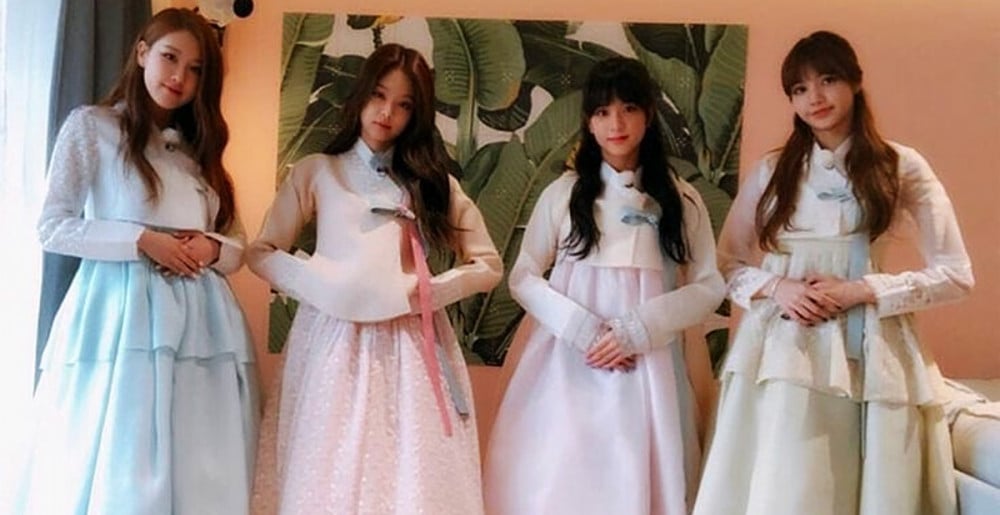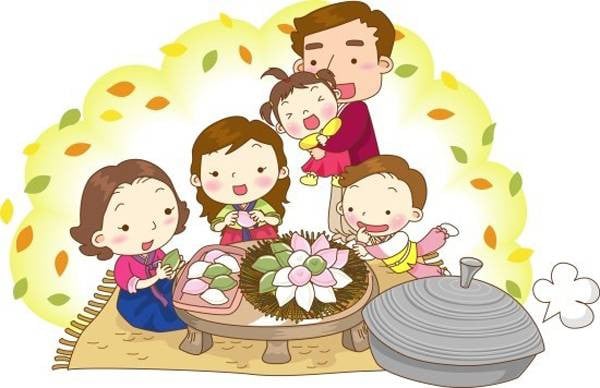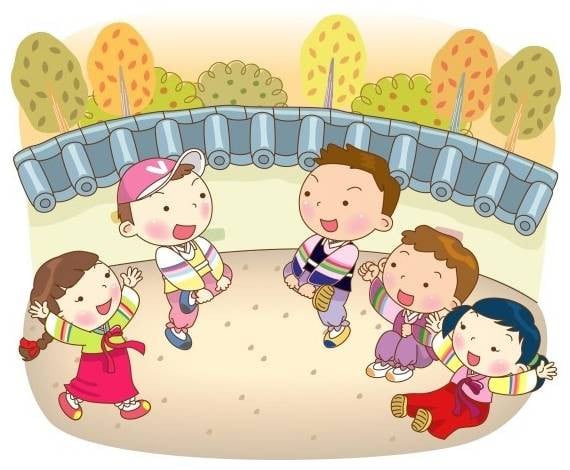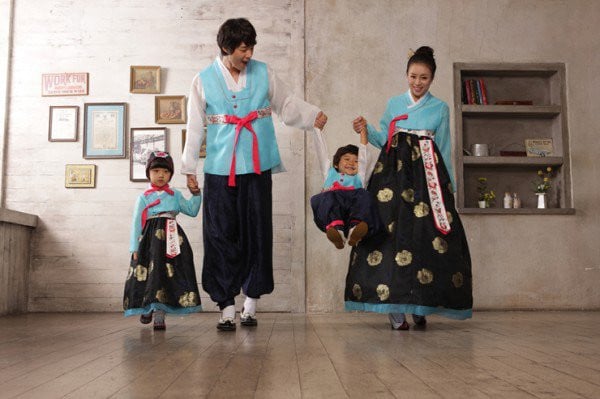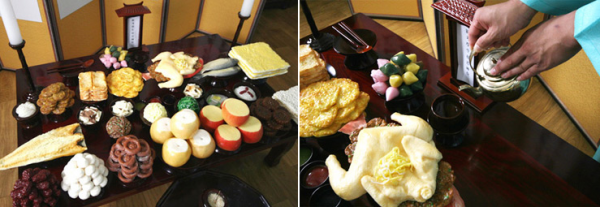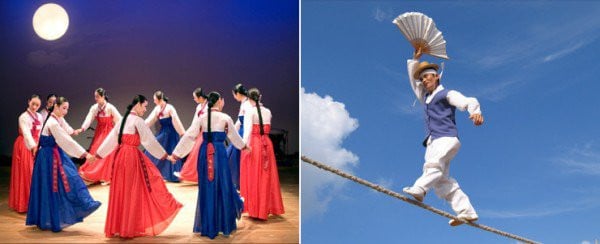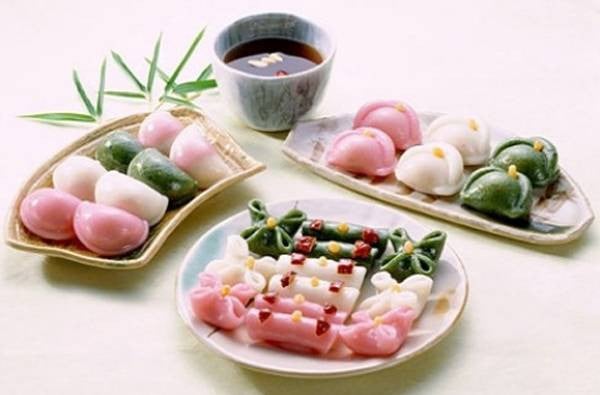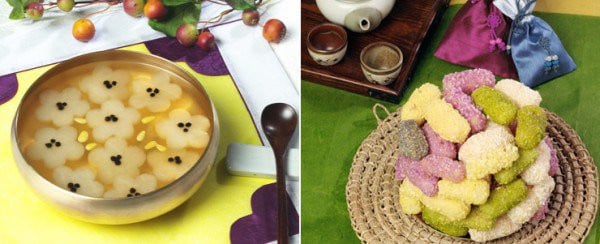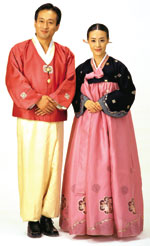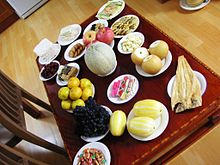
Чхусок – один из главнейших корейских семейных праздников, когда люди собираются вместе за вкусным столом, чтобы отдохнуть в кругу близких людей и по традиции почтить предков. Чхусок обычно празднуют осенью и в 2021 году он выпал на 21 сентября, таким образом, праздничные дни в этом году продлятся с 18 по 22 сентября (включая выходные). С наступлением этого важного осеннего торжества многие корейцы навещают своих родственников, чтобы провести время в семейном кругу. Давайте побольше узнаем о важном корейском празднике Чхусок и о том, как его можно провести.
Значение праздника Чхусок (Хангави)
Как уже было отмечено, Чхусок – это один из трёх самых главных праздников Кореи, наряду с Новым годом по лунному календарю Соллаль и праздником Тано, который отмечается в честь завершения весенних полевых работ. Праздник Чхусок также именуют «Хангави». Это название складывается из слова «хан», что означает «большой», а также сочетания «гави», то есть «середина осени». Таким образом, это название обозначает, что в день урожая Чхусок, приходящийся на 15-й день 8-го месяца по лунному календарю, раз в год на небе восходит самая большая полная луна.
Традиции празднования Чхусок
Поклонение духам «чхаре» (차례) и посещение могил предков «сонмё» (성묘)
Утром в Чхусок в каждом доме в кругу семьи проводится церемония жертвоприношения духам предков. Во время праздников или важных событий также традиционно было принято надевать новую одежду «пим». Подобную церемонию обычно проводят два раза в год: в Новый год по лунному календарю Соллаль и в праздник Чхусок. В день Чхусок на стол обычно подают рис, алкогольные напитки и рисовые хлебцы «сонпхён». После завершения этой церемонии все члены семьи вкушают разложенные на жертвенном столе блюда. Также, после церемонии чхаре в Чхусок принято посещать могилы предков, то есть совершать «сонмё» (성묘), и пропалывать траву и сорняки, то есть осуществлять «польчхо» (벌초). Это считается проявлением почтительности и уважения по отношению к предкам, что, в свою очередь, является обязательным долгом каждого достойного человека.
Традиционные народные игры, проводимые в празднование Чхусока
Праздник Чхусок совпадает с осенней порой сбора урожая – порой изобилия и достатка. Ещё с давних времен у корейского народа существовало множество различных традиционных игр. Наиболее известные среди них – «самульнори» (игра на 4 традиционных ударных инструментах), «тхальчхум» — танец в масках и т.д., но не стоит забывать и о танце «канган сулле» и борьбе «ссирым». Во время праздника полной луны Чонволь тэборым, а также на Чхусок замужние женщины и молодые девушки, облачившись в корейскую традиционную одежду «ханбок» и исполняя народные песни, водят хороводы. Этот обычай называется «канган сулле». Существует несколько версий происхождения этого ритуала. Согласно одной из легенд, в эпоху правления династии Ли (1392–1910 гг.), когда на Корею хотели напасть враги, все женщины, нарядившись в военные одеяния, поднялись на гору и водили там хороводы. В результате у врага создалось ложное впечатление о значительных силах противника, и эта хитрость принесла корейцам победу. Считается, что традиция водить хороводы восходит именно к этой военной тактике. Ссирым – это традиционная борьба, в которой двое участников один на один соревнуются между собой в силе и ловкости на песчаной площадке.
Праздничный стол
Чхусок считается символом изобилия. Поэтому в этот день готовят различные блюда. Обязательным на столе лакомством во время празднования Чхусока являются рисовые хлебцы «сонпхён», представляющие собой небольшую лепешку из отбитого риса или с начинкой из семян кунжута, сладких бобов и каштанов. Примечательно, что используемые в качестве начинки ингредиенты прессуются на доске, посыпанной сосновыми иголками, отчего они приобретают лёгкий аромат сосны. В преддверии праздника вся семья собирается вместе, чтобы приготовить «сонпхён». Считается, что у того, кто сумеет слепить «сонпхён» аккуратными и ровными, спутник жизни или дети будут красивыми и добрыми. Ещё одним элементом, без которого не обходится праздничный стол на Чхусок, является традиционный алкоголь и лепёшки «чжон», приготовленные из мучного теста, с добавлением яиц, мелко нарезанных приправленных рыбы или мяса, а также овощей, обжаренные в масле. Во время Чхусока за одним столом собираются родственники, которые обычно живут в разных районах страны далеко друг от друга. Они совершают церемонию поминовения предков, в которой используется алкоголь, приготовленный из риса нового урожая. После окончания всех церемоний родственники едят пищу и наслаждаются вином из свежесобранного риса, а также ведут задушевные беседы.
Дополнительная информация
-
Туристические достопримечательности, которые стоит посетить во время Чхусока
-
— Дворец Кёнбоккун
— Дворец Чхандоккун и Тайный сад Хувон
— Дворец Чхангёнгун
— Дворец Токсугун
— Деревня традиционных домов ханок на Намсане
— Национальный музей Кореи
— Национальный музей современного искусства в Сеуле
— Парк развлечений Lotte World -
※ Перед посещением советуем проверять время работы достопримечательностей
-
Статья по теме
Учимся готовить традиционные блюда на праздник Чхусок!
-
Центр Туристической Информации Кореи
+82-2-1330 (кор., англ., яп., кит., рус., вьет., тай., малай. и индонез.)
- *Статья была опубликована в сентябре 2021 года. В дальнейшем возможны изменения, поэтому рекомендуем проверять информацию непосредственно перед путешествием.
Вновь наступило то время, когда все айдолы и знаменитости делятся своими фотографиями в ярких ханбоках. Время Чусока!
Для новеньких к-поперов, которые пока только начинают знакомиться с культурой Южной Кореи.
Может показаться неожиданным, но Чусок один из четырёх главных праздников в Корее. В этом году Чусок отмечали 10 сентября, в субботу, а по рабочему календарю праздники выпали с 9 по 12 сентября, с пятницы по понедельник. Два года из-за ковида семьи не могли проводить этот праздник вместе. Наконец, когда многие социальные ограничения были сняты, семьи снова могут объединиться!
Читайте далее, чтобы узнать побольше о Чусоке.
Чусок иногда называют “Корейский день благодарения”. “Хангави”, “Чончунджул” или “Гейб” — это разные названия празднования ярчайшего полнолуния года, которое выпадает на 15 число восьмого месяца по лунному календарю, где-то между сентябрём и началом октября.
В отличие от запада, корейцы по-прежнему используют лунный календарь для определения важных дат, поэтому многие их праздники основываются на лунных циклах. Например, в 2023 году празднование Чусока выпадает на 29 сентября, а в 2024 он будет отмечаться 17 сентября.
Чусок — праздник хорошего урожая.
Так сложилось исторически. Примерно в это время наступает пора для сбора урожая спелых, свежих фруктов и зёрен.
Чтобы отпраздновать удачный урожай, семьи собираются и приезжают в свои родные города, в отчие дома, другими словами бон-га (дословно переводится как “главный дом”, обычно это дом главы семьи — бабушки с дедушкой или родителей). Родные одеваются в традиционные одежды, готовят вкусную еду и отдают дань уважения своим предкам.
Как можно заметить, уважение к старшим — характерная черта корейцев.
Чусок не обычный праздник, существуют три основные обязанности, которые непременно должны быть выполнены:
1. “Бульчо”. Уход за местами погребения родственников. Важно прополоть их от сорняков, которые росли там всё лето.
Это первостепенная задача для всей семьи, потому что в корейской культуре (и азиатской культуре в целом) всегда следят за тем, чтобы “сохранить лицо” перед другими людьми. Когда кто-то совершает ошибку, первой мыслью будет не “Ох, что же делать?”, а “Что же подумают люди?”.
Могилы, возле которых остались сорняки после Чусока, заставят людей подумать, что у этих умерших безответственные дети, а это позор для семьи.
2. “Санмаё”. Оказание уважения могиле. Обычно в форме поклонения перед ней и возложения алкоголя, фруктов, мяса и специального корейского сладкого рисового напитка — Сикхе.
3. “Чарие”. Тщательно продуманная сервировка стола для предков дома. Есть конкретные последовательные шаги, чтобы сделать всё правильно. Например, нужно зажечь свечи перед тем, как алкоголь будет разлит в три разных стакана, а затем дважды поклониться.
У каждого блюда есть своё точное место на столе.
Когда все обязательные этапы выполнены, наступает время для игр.
Сейчас семьи уже не играют в устаревшие игры, предпочитая общение и посиделки в кругу семьи за Годори (популярная в Азии карточная игра). Однако, старые игры ещё интересны для общественных мероприятий и телевидения.
1. Канган-сулле. Игра, где девушки водят хороводы под луной, держась за руки.
2. Сонори. Двое людей надевают накидку из хэнджи (традиционной корейской бумаги из тутовых деревьев) и бегают от дома к дому, изображая корову или черепаху, и прося угощения. Такой едой часто делятся с семьями, которые не могут позволить себе традиционный обед на Чусок.
Другие игры включают в себя борьбу, перетягивание каната и стрельбу из лука.
Многие айдолы не могут дождаться, чтобы приготовить и съесть сонпхён на Чусок.
Они часто выкладывают в свои соц сети фото и видео с этим блюдом.
«G-Dragon идеально подходит для Miu Miu» считают фанаты, поскольку люксовый бренд присылает ему подарки на Чусок
Сонпхён — это одно из традиционных блюд во время Чусока. Оно делается из только что собранного риса. Сонпхён представляет из себя небольшой пирожок в виде полумесяца с начинкой из красной фасоли, каштанов, мармелада, молотого кунжута или просто тростникового сахара.
Во время приготовления сонпхёна следует загадать желание, а затем осторожно взять начинку и слепить полумесяц так, чтобы твоё желание не выпало вместе с начинкой. Старшие обычно ворчат, что лепить нужно аккуратнее и красивее, ведь считается, что чем идеальней форма у сонпхёна, тем красивее будет твоя будущая дочь.
И потом, конечно, все наслаждаются едой в кругу семьи.
Мы надеемся, что статья оказалась полезной и вы смогли больше узнать о Чусоке!
Noona © YesAsia.ru
| Chuseok | |
|---|---|
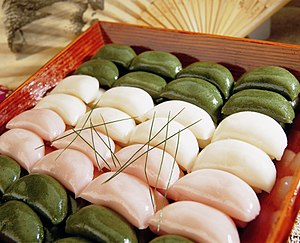
Songpyeon, a type of tteok to celebrate Chuseok. |
|
| Official name | Chuseok (추석, 秋夕) |
| Also called | Hangawi, Jungchujeol |
| Observed by | Koreans |
| Type | Cultural, religious (Buddhist, Confucian, Muist) |
| Significance | Celebrates the harvest |
| Observances | Visit to their family’s home town, ancestor worship, harvest feasts with songpyeon and rice wines |
| Begins | 14th day of the 8th lunar month |
| Ends | 16th day of the 8th lunar month |
| Date | 15th day of the 8th month of the Chinese lunar calendar |
| 2022 date | 9 September – 11 September |
| 2023 date | 28 September – 30 September |
| 2024 date | 6 September – 8 September |
| 2025 date | 16 September — 18 September |
| Frequency | Annual |
| Related to | Mid-Autumn Festival (in China) Tsukimi (in Japan) Tết Trung Thu (in Vietnam) Uposatha of Ashvini/Krittika (similar festivals that generally occur on the same day in Cambodia, India, Sri Lanka, Myanmar, Laos, and Thailand ) |
| Korean name | |
| Hangul |
추석 |
|---|---|
| Hanja |
秋夕 |
| Revised Romanization | chuseok |
| McCune–Reischauer | ch’usŏk |
| IPA | [tɕʰusʌk̚] |
| Original Korean name | |
| Hangul |
한가위 |
| Revised Romanization | han-gawi |
| McCune–Reischauer | han’gawi |
| IPA | [hɐnɡɐɥi] |
Chuseok (Korean: 추석; Hanja: 秋夕; [tɕʰu.sʌk̚], literally «autumn evening»), also known as Hangawi (Hangul: 한가위; [han.ɡa.ɥi]; from archaic Korean for «the great middle (of autumn)»), is a major mid-autumn harvest festival and a three-day holiday in South Korea celebrated on the 15th day of the 8th month of the lunar calendar on the full moon. In North Korea, they only celebrate for the day of chuseok.[1] Like many other harvest festivals around the world, it is held around the autumn equinox, i.e. at the very end of summer or in early autumn. It is the biggest traditional holiday in South Korea.
As a celebration of the good harvest, Koreans visit their ancestral hometowns and share a feast of Korean traditional food such as songpyeon (Korean: 송편; Hanja: 松䭏), yakgwa, fruits like Asian pear and hallabong, and rice wines such as sindoju (Korean: 신도주; Hanja: 新稻酒). and dongdongju (Korean: 동동주; Hanja: 浮蟻酒). There are two major traditions related to Chuseok: Charye (Korean: 차례; Hanja: 茶禮, ancestor memorial services at home, also known as Jesa), and Seongmyo (Korean: 성묘; Hanja: 省墓, family visit to the ancestral graves), which is usually accompanied by Beolcho (Korean: 벌초; Hanja: 伐草, tidying graves, removing weeds around them).[2] Another major custom is to prepare the family’s ancestors their favorite meals as an offering.
Origins[edit]
According to popular belief, Chuseok originates from gabae (Korean: 가배; Hanja: 嘉俳·嘉排). Gabae started during the reign of the third king of the kingdom of Silla (57 BC — 935 AD), when it was a month-long weaving contest between two teams.[3][4] On the day of Gabae, the team that had woven more cloth won and would be treated to a feast by the losing team. It is believed that weaving competitions, archery competitions, and martial arts demonstrations were held as part of the festivities.[5]
Many scholars also believe Chuseok may originate from ancient shamanistic celebrations of the harvest moon.[4] New harvests are offered to local deities and ancestors, which means Chuseok may have originated as a worship ritual.[6] In some areas, if there is no harvest, worship rituals are postponed, or in areas with no annual harvest, Chuseok is not celebrated.[citation needed]
Traditional customs[edit]
Another table with many traditional food offerings on it
In contemporary South Korea, on Chuseok, masses of people travel from large cities to their hometowns to pay respect to the spirits of their ancestors.[7] Chuseok celebrates the bountiful harvest and strives for the next year to be better than the last. People perform ancestral worship rituals early in the morning. Then, they visit the tombs of their immediate ancestors to trim plants, clean the area around the tomb, and offer food, drink, and crops to their ancestors.[7] The rest of the day is spent playing folk games and bonding with the family members. South Koreans consider autumn the best season of the year due to clear skies, cool winds, and it is the perfect harvesting weather. Harvest crops are attributed to the blessing of ancestors. Chuseok is commonly incorrectly translated as «Korean Thanksgiving» in American English despite the holidays being vastly different in origin and celebration.[8] Although most South Koreans visit their families and ancestral homes, there are festivities held at the National Folk Museum of Korea. Many places are closed during this national holiday, including banks, schools, post offices, governmental departments, and stores. Airline tickets to South Korea around the festival are usually sold out three months in advance and roads and hotels are overcrowded.[9]
Charye[edit]
Charye is one of the ancestral memorial rites celebrated during Chuseok, symbolizing the abundance of the harvest season and honoring ancestors and past generations.[10] The rite involves the gathering of families in holding a memorial service for their ancestors through the harvesting, preparation and presentation of special foods as offerings.[11] Preparation for the food usually takes hours and many families start the cooking process early in the morning. The rite embodies the traditional view of spiritual life beyond physical death, respecting the spirits of the afterlife that now also serve to protect their descendants. The foods offered vary across provinces depending on what is available, but commonly feature freshly harvested rice, rice cakes (songpyeon) and fresh meat, fruit and vegetables.[12] The arrangement of the foods of Charye on the table is also notable: traditionally rice and soup are placed on the north and fruits and vegetables are placed on the south; meat dishes are served on the west and in the middle, and rice cake and some drinks such as makgeolli or soju are placed on the east. These details can vary across regions.[13]
Hanbok[edit]
The hanbok (in South Korea) or Choson-ot (in North Korea) is the traditional dress that the Korean people wear on special holidays and formal and semi-formal occasions, such as Chuseok, Lunar New Year, and weddings. The term «hanbok» literally means «Korean clothing.» The basic structure of the hanbok consists of the jeogori jacket, baji pants, chima skirt, and the po coat. The design of the hanbok remains unchanged to this day and is designed in a variety of colors.[14]
Food[edit]
Songpyeon[edit]
One of the major foods prepared and eaten during the Chuseok holiday is songpyeon (Hangul: 송편; 松餠), a Korean traditional rice cake[7] made with ingredients such as sesame seeds, black beans, mung beans, cinnamon, pine nut, walnut, chestnut, jujube, and honey.
When making songpyeon, steaming them over a layer of pine-needles is critical. The word song in songpyeon means a pine tree in Korean. The pine needles not only contribute to songpyeon’s aromatic fragrance, but also its beauty and taste.[15][16]
Songpyeon is also significant because of the meaning contained in its shape. However, some songpyeon are shaped like a ball. Songpyeon’s rice skin itself resembles the shape of a full moon, but once it wraps the stuffing, its shape resembles the half-moon. Since the Three Kingdoms era in Korean history, a Korean legend stated that these two shapes ruled the destinies of the two greatest rival kingdoms, Baekje and Silla. During the era of King Uija of Baekje, an encrypted phrase, «Baekje is full-moon and Silla is half-moon» was found on a turtle’s back and it predicted the fall of the Baekje and the rise of the Silla. The prophecy came true when Silla defeated Baekje. Ever since Koreans have believed a half-moon shape is an indicator of a bright future or victory.[16] Therefore, during Chuseok, families gather together and eat half-moon-shaped Songpyeon under the full moon, wishing for a brighter future.[17] There’s a belief that if a single woman makes a pretty songpyeon, she will find a great husband, and if a pregnant woman makes a pretty songpyeon, she will have a pretty daughter.[18]
Hangwa[edit]
Another popular Korean traditional food that people eat during Chuseok is hangwa. It is a general term to categorize sweet foods made with tteok, meaning rice cake. It is an artistic food decorated with natural colors and textured with patterns. Hangwa, also known as Hang, is made with rice flour, honey, fruit, and roots. People use edible natural ingredients to express various colors, flavours, and tastes. Because of its decoration and nutrition, Koreans eat hang not only during Chuseok, but also for special events, for instance, weddings, birthday parties, and marriages.[19]
The most famous types of hangwa are yakgwa, yugwa, and dasik. Yakgwa is a sweet honey cookie which is made of fried rice flour dough ball and yugwa is a fried cookie consisting of glutinous rice mixed with honey water, and cheongju (rice wine). Dasik is a tea cake that people enjoy with tea.[20]
Baekju[edit]
A major element of Chuseok is alcoholic drinks. Liquor drunk on Chuseok is called baekju (백주, 白酒, literally «white wine») and nicknamed sindoju (신도주, 新稻酒, literally «new rice liquor») as it is made of freshly harvested rice.[21][22]
Kooksoondang, a maker of Korean traditional liquors, restored «Yihwaju», rice wine from the Goryeo era (918–1392), and «Songjeolju» that has been widely enjoyed by Joseon (1392–1910) aristocrats. Its «Jamyang Baekseju» package comprises a variety of liquors ― Jayang Baekseju, Jang Baekseju, Baekokju ― that are claimed to enhance men’s stamina.[23]
Adults say that if you drink the alcoholic beverage which the ancestors have drunk; there will be nothing you’ll be scared of.[citation needed]
Others[edit]
Other foods commonly prepared are japchae, bulgogi, an assortment of Korean pancakes also known as jeon, saengseon (fried fish), tteokguk (rice cake soup), and fruits.
Gifts[edit]
History of Chuseok gifts[edit]
The Korean people started sharing daily necessities, such as sugar, soap or condiments, as Chuseok gifts in the 1960s. The gifts have changed since the Korean economy has developed. In the 1970s, Korean people had more options for Chuseok gifts; examples include cooking oil, toothpaste, instant coffee sets, cosmetics, television and rice cookers. People chose gift sets of fruit, meat and cosmetics in the 1980s. In the 1990s, people used gift vouchers for Chuseok. In the 21st century, more sophisticated gifts, such as sets of sweet desserts, spam, fruits, health supplements, and skincare have become the most popular options for Chuseok gifts.[24]
Types of Chuseok gifts and prices[edit]
Some extravagant gifts can be purchased: one kilogram of wild pine mushrooms, which are expensive because they cannot be artificially grown, (560,000 won) US$480.27 and red ginseng products (1.98 million won) US$1698.11. However, the most exorbitantly priced gift is six bottles of wine at Lotte Department Store for a staggering (33 million won) US$28,301.89.[25]
Chuseok gift sets are big business in Korea and prices are typically inflated around the holiday.[26]
Folk games[edit]
A variety of folk games are played on Chuseok to celebrate the coming of autumn and rich harvest. Sonori is a folk performance where Village folk dress themselves to resemble a cow or turtle and go from house to house along with a nongak band playing pungmul music. Other common folk games played on Chuseok are talchum (mask dance), board game called Yut Nori, (also known as Yunnori, Nyout, and Yout), archery, ssireum,(Korean wrestling), and juldarigi;[27] folk games vary by region.
Ssireum[edit]
Ssireum (Hangul: 씨름) is the most popular Korean sport played during Chuseok and contests are usually held during this holiday. Scholars have found evidence for ssireums dating back to the Goguryeo dynasty, Ssireum is assumed to have 5000 years of history. Two players wrestle each other while holding onto their opponent’s satba, a red and blue band. A player loses when his upper body touches the ground, and the winner becomes Cheonha Jangsa, Baekdu Jangsa, or Halla Jangsa, meaning «the most powerful». The winner gets a bull and 1 kg (2.2 lb) of rice as the prize.[28] Due to its popularity among both the young and the old, ssireum contests are held more frequently, not limited to important holidays.
Taekkyon[edit]
Taekkyon (Hangul: 태껸 or 택견) is one of the oldest traditional martial arts of Korea. Taekkyon was very popular during the Joseon period (1392-1897) where it was practised alongside Ssireum during festivities, including Chuseok. Though originally a hand-to-hand fighting method, plebs used a more tamed version alike to a kicking game. The practitioner uses the momentum of his opponent to knock him down through kicks, swipes and pushes.[29] Tournaments between players from different villages were carried out, starting with the children («Aegi Taekkyon») before finishing with the adults.
Taekkyon almost disappeared during the Japanese occupation (1910-1945) but is now considered a cultural heritage of Korea (1983) and a UNESCO intangible cultural item (2011).[30]
Ganggangsullae[edit]
The Ganggangsullae (Hangul: 강강술래) dance is a traditional folk dance performed under the full moon in the night of Chuseok.[31] Women wear Korean traditional dress, hanbok, make a big circle by holding hands, and sing a song while going around a circle. Its name, Ganggangsullae, came from the refrain repeated after each verse, and contains no actual meaning.
The dance originated in the southern coastal area of Korea. To watch a video clip of the Ganggangsullae dance, click here.[clarify]
For other folk games, they also play Neolttwigi (also known as the Korean plank), a traditional game played on a wooden board.[32]
Juldarigi[edit]
Juldarigi (Hangul: 줄다리기), or tug-of-war, was enjoyed by an entire village population. Two groups of people are divided into two teams representing the female and male forces of the natural world. The game is considered an agricultural rite to predict the results of the year’s farming. If the team representing the female concept won, it was thought the harvest that year would be rich.
Chicken Fight (Dak SSa Umm)[edit]
Korean people used to watch chicken fights (Hangul: 닭싸움), and learned how chickens fought; a game inspired by such was invented.
To play the game, people are separated into two balanced groups. One must bend his or her leg up and hold it bent with the knee poking out. The players must then attack each other with their bent knees, having to eliminate them by making their feet touch the ground; the last player holding up his or her knee wins.
The game is about strength, speed, and balance; to stay alive, one must display the capability of fighting back.[33]
Hwatu[edit]
Hwatu (Hangul: 화투, also known as Go-Stop or Godori) is composed of 48 cards including 12 kinds. The rules of the game and the term water originated from Tujeon.
It was formerly similar to Hanafuda, but was changed due to similarities with the latter. It went through a course that made it reduced by four base colors and thinner than before, spreading throughout to turn out goods on a mass-produced basis.[clarification needed]
Chuseok in North Korea[edit]
Since Chuseok is a traditional holiday that has been celebrated long before the division of Korea, people in North Korea also celebrate Chuseok. However, the ideology that divided Korea also caused some differences between the way that the holiday is celebrated in North Korea from the way it is celebrated in South Korea.[34] In fact, North Korea did not celebrate Chuseok and other traditional holidays until the mid-1980s.
While South Koreans celebrate Chuseok by visiting and spending time with family members, most North Koreans do not have any family gatherings for the holiday. Some, especially those in working classes, try to visit their ancestors’ gravesites during Chuseok. However, social and economic issues in North Korea have been preventing visits.[35] In addition, the extremely poor infrastructure of North Korea, especially in terms of public transportation, makes it almost impossible for people to visit grave sites and their families.[36] In contrast to the poor Songbun lower class North Koreans, middle and elite classes enjoy the holiday as they want, easily traveling wherever they want to go.[36]
See also[edit]
- Hansik, another Korean holiday for ancestral rituals
- List of Buddhist festivals
- List of harvest festivals
- List of festivals in South Korea
- Public holidays in South Korea
- List of Korean traditional festivals
Sources[edit]
- The Academy of Korean Studies, ed. (1991), «Chuseok», Encyclopedia of Korean People and Culture, Woongjin (in Korean)
- Farhadian, Charles E. (2007). Christian Worship Worldwide. Wm. Bm. Eerdmans Publishing. ISBN 978-0-8028-2853-8.
- Korea University Institute of Korean Culture, ed. (1982). «Social Life». Korean Heritage Overview. Vol. 1. Korea University.(in Korean)
- Aviles, K. (2011, September 10). Chuseok : A Festival With Two Faces. International Business Times. Retrieved December 4, 2012[37]
- Im, J. J. (2010, September 23). Daily NK — Welcome to Chuseok, North Korean Style. DailyNK. Retrieved December 4, 2012[38]
- Kim, K.-C. (2008). Ganggangsullae. UNESCO Multimedia Archives. Retrieved December 4, 2012[39]
- Korea.net. (2012, February 5). Chuseok, Korean Thanksgiving Day (English) — YouTube. YouTube. Retrieved December 4, 2012[40]
- Moon, S. H. (2008, September 16). Daily NK — New Chuseok Trends in North Korea. DailyNK. Retrieved December 4, 2012
- Official Korea Tourism. (2008, August 26). Official Site of Korea Tourism Org.: Chuseok: Full Moon Harvest Holiday, Korean Version of Thanksgiving Day. VisitKorea. Retrieved December 4, 2012
- The National Folklore Museum of Korea. (n.d.). Ancestral Memorial Rites — Charye | The National Folklore Museum of Korea. The National Folklore Museum of Korea. Retrieved December 5, 2012[41]
- TurtlePress (Martial Arts Video). (2009, May 1). SSireum Korean Wrestling History — YouTube. YouTube. Retrieved December 4, 2012[42]
- Yoo, K. H. (2009, October 5). Chuseok, North Korean Style. DailyNK. Retrieved December 4, 2012[43]
References[edit]
- ^ Passport to Korean Culture By Published by Korean Culture and Information Service Ministry of Culture, Sports and Tourism
- ^ «Chuseok (A Korean Thanksgiving)». chuseok.org. April 2021.
- ^ The Academy of Korean Studies, ed. (1991.) «Chuseok», Encyclopedia of Korean People and Culture, Woongjin (in Korean).
- ^ a b Farhadian, Charles E. (2007.) Christian Worship Worldwide. Wm. Bm. Eerdmans Publishing. ISBN 978-0-8028-2853-8.
- ^ , Yun, Sŏ-sŏk Yun. (2008.) Festive occasions: the customs in Korea, Ewha Womans University Press, Seoul. ISBN 978-8-9730-0781-3.
- ^ Korea University Institute of Korean Culture, ed. (1982.) «Social Life», Korean Heritage Overview, 1, Korea University (in Korean).
- ^ a b c «Traditional Korean Holiday, Chuseok». Imagine Your Korea. Retrieved 22 September 2016.
- ^ «Chuseok: Korean Thanksgiving Day». Asia Society. Retrieved 22 September 2016.
- ^ Lee, Cecilia Hae-Jin (2010). Frommer’s South Korea. Hoboken, N.J, Chichester: Wiley, John Wiley. pp. 21, 22, 25. ISBN 978-0470591543.
- ^ «Korean Ancestral Memorial Rites, Jerye. — South-Korea — korea4expats». Korea4expats.com.
- ^ «A time for families, food and festivities». Jejuweekly.com.
- ^ «Traditional Korean Holiday of Bountiful Harvest, Chuseok | Official Korea Tourism Organization». English.visitkorea.or.kr. Retrieved 2018-08-22.
- ^ «메세지 페이지». Nfm.go.kr.
- ^ «Chuseok Hanbok». Chuseok.org. 12 March 2022.
- ^ «Official Site of Korea Tourism Org.: Chuseok – Full Moon Harvest Holi…». Archived from the original on 21 February 2013.
- ^ a b «No Chuseok Without Songpyeon». English.chosun.com. Retrieved 27 December 2018.
- ^ «Official Site of Korea Tourism Org.: Chuseok – Full Moon Harvest Holi…». Archived from the original on 21 February 2013.
- ^ «What are the types of TTEOK 떡 (Rice Cakes) and their meanings?». Hyphe-Nated. Retrieved 9 September 2021.
- ^ «Hangwa –Korean Traditional Confectionaries Good for the Body and the Soul — INSIDE Koreabrand.net». www.koreabrand.net. Archived from the original on 18 January 2012. Retrieved 14 January 2022.
- ^ «Korea Tour Guide». English.visitKorea.or.kr. Retrieved 22 September 2016.
- ^ 임동권 (Im Dong-kwon) (1996). «Chuseok». 한국민족문화대백과사전 (Encyclopedia of Korean Culture) (in Korean). Retrieved 2021-08-18.
- ^ «Let’s Share the Happiness of Harvest on Chuseok». AgraFood. August 29, 2011. Archived from the original on 2016-12-20. Retrieved 2016-12-09.
- ^ «Chuseok, sharing the spirit of gratitude». Korea Herald. September 6, 2013. Retrieved 27 December 2018.
- ^ «한국을 대표하는 글로벌 방송! The World On Arirang!». Arirang.com. Retrieved 27 December 2018.
- ^ «Dollar : 네이버 통합검색». Archived from the original on 2021-08-20. Retrieved 2016-12-09.
- ^ «10 Ridiculously Priced Korean Chuseok Gift Sets — 10 Magazine Korea». 10mag.com. 23 September 2015.
- ^ «Chuseok Games». Chuseok.org. 13 March 2022.
- ^ What’s on Korea. (2001, July 28) Archived 2006-05-23 at the Wayback Machine
- ^ «the importance of Taekkyon in Korean traditional culture».
- ^ «Taekkyon entry on UNESCO’s world heritage list».
- ^ Seoul City. (2004, September 2) Archived 2013-04-19 at archive.today
- ^ «Festivals, events to delight on Chuseok holidays». Korea.net. Retrieved 22 September 2016.
- ^ «Wikispaces». Archived from the original on 2018-07-31.
- ^ «Chuseok— A Festival With Two Faces». International Business Times. 10 September 2011.
- ^ «Archived copy». Archived from the original on 2018-01-07. Retrieved 2018-12-27.
{{cite web}}: CS1 maint: archived copy as title (link) - ^ a b Jin, Im Jeong (23 September 2010). «Welcome to Chuseok, North Korean Style». Dailynk.com.
- ^ «Chuseok— A Festival With Two Faces». International Business Times. 10 September 2011. Retrieved 27 December 2018.
- ^ Jin, Im Jeong (23 September 2010). «Welcome to Chuseok, North Korean Style». Dailynk.com. Retrieved 27 December 2018.
- ^ Kwang-shik-CHA, Kim. «Ganggangsullae». Unesco.org. Retrieved 27 December 2018.
- ^ «Chuseok, Korean Thanksgiving Day (English)». YouTube. Retrieved 27 December 2018.
- ^ «메세지 페이지». Nfm.go.kr. Retrieved 27 December 2018.
- ^ «SSireum Korean Wrestling History». YouTube. Retrieved 27 December 2018.
- ^ Hee, Yoo Gwan (5 October 2009). «Chuseok, North Korean Style». Dailynk.com. Retrieved 27 December 2018.
External links[edit]
Media related to Chuseok at Wikimedia Commons
- Chuseok, Korean Thanksgiving Day on YouTube
- Chuseok, North Korean Thanksgiving Day on YouTube
| Chuseok | |
|---|---|

Songpyeon, a type of tteok to celebrate Chuseok. |
|
| Official name | Chuseok (추석, 秋夕) |
| Also called | Hangawi, Jungchujeol |
| Observed by | Koreans |
| Type | Cultural, religious (Buddhist, Confucian, Muist) |
| Significance | Celebrates the harvest |
| Observances | Visit to their family’s home town, ancestor worship, harvest feasts with songpyeon and rice wines |
| Begins | 14th day of the 8th lunar month |
| Ends | 16th day of the 8th lunar month |
| Date | 15th day of the 8th month of the Chinese lunar calendar |
| 2022 date | 9 September – 11 September |
| 2023 date | 28 September – 30 September |
| 2024 date | 6 September – 8 September |
| 2025 date | 16 September — 18 September |
| Frequency | Annual |
| Related to | Mid-Autumn Festival (in China) Tsukimi (in Japan) Tết Trung Thu (in Vietnam) Uposatha of Ashvini/Krittika (similar festivals that generally occur on the same day in Cambodia, India, Sri Lanka, Myanmar, Laos, and Thailand ) |
| Korean name | |
| Hangul |
추석 |
|---|---|
| Hanja |
秋夕 |
| Revised Romanization | chuseok |
| McCune–Reischauer | ch’usŏk |
| IPA | [tɕʰusʌk̚] |
| Original Korean name | |
| Hangul |
한가위 |
| Revised Romanization | han-gawi |
| McCune–Reischauer | han’gawi |
| IPA | [hɐnɡɐɥi] |
Chuseok (Korean: 추석; Hanja: 秋夕; [tɕʰu.sʌk̚], literally «autumn evening»), also known as Hangawi (Hangul: 한가위; [han.ɡa.ɥi]; from archaic Korean for «the great middle (of autumn)»), is a major mid-autumn harvest festival and a three-day holiday in South Korea celebrated on the 15th day of the 8th month of the lunar calendar on the full moon. In North Korea, they only celebrate for the day of chuseok.[1] Like many other harvest festivals around the world, it is held around the autumn equinox, i.e. at the very end of summer or in early autumn. It is the biggest traditional holiday in South Korea.
As a celebration of the good harvest, Koreans visit their ancestral hometowns and share a feast of Korean traditional food such as songpyeon (Korean: 송편; Hanja: 松䭏), yakgwa, fruits like Asian pear and hallabong, and rice wines such as sindoju (Korean: 신도주; Hanja: 新稻酒). and dongdongju (Korean: 동동주; Hanja: 浮蟻酒). There are two major traditions related to Chuseok: Charye (Korean: 차례; Hanja: 茶禮, ancestor memorial services at home, also known as Jesa), and Seongmyo (Korean: 성묘; Hanja: 省墓, family visit to the ancestral graves), which is usually accompanied by Beolcho (Korean: 벌초; Hanja: 伐草, tidying graves, removing weeds around them).[2] Another major custom is to prepare the family’s ancestors their favorite meals as an offering.
Origins[edit]
According to popular belief, Chuseok originates from gabae (Korean: 가배; Hanja: 嘉俳·嘉排). Gabae started during the reign of the third king of the kingdom of Silla (57 BC — 935 AD), when it was a month-long weaving contest between two teams.[3][4] On the day of Gabae, the team that had woven more cloth won and would be treated to a feast by the losing team. It is believed that weaving competitions, archery competitions, and martial arts demonstrations were held as part of the festivities.[5]
Many scholars also believe Chuseok may originate from ancient shamanistic celebrations of the harvest moon.[4] New harvests are offered to local deities and ancestors, which means Chuseok may have originated as a worship ritual.[6] In some areas, if there is no harvest, worship rituals are postponed, or in areas with no annual harvest, Chuseok is not celebrated.[citation needed]
Traditional customs[edit]
Another table with many traditional food offerings on it
In contemporary South Korea, on Chuseok, masses of people travel from large cities to their hometowns to pay respect to the spirits of their ancestors.[7] Chuseok celebrates the bountiful harvest and strives for the next year to be better than the last. People perform ancestral worship rituals early in the morning. Then, they visit the tombs of their immediate ancestors to trim plants, clean the area around the tomb, and offer food, drink, and crops to their ancestors.[7] The rest of the day is spent playing folk games and bonding with the family members. South Koreans consider autumn the best season of the year due to clear skies, cool winds, and it is the perfect harvesting weather. Harvest crops are attributed to the blessing of ancestors. Chuseok is commonly incorrectly translated as «Korean Thanksgiving» in American English despite the holidays being vastly different in origin and celebration.[8] Although most South Koreans visit their families and ancestral homes, there are festivities held at the National Folk Museum of Korea. Many places are closed during this national holiday, including banks, schools, post offices, governmental departments, and stores. Airline tickets to South Korea around the festival are usually sold out three months in advance and roads and hotels are overcrowded.[9]
Charye[edit]
Charye is one of the ancestral memorial rites celebrated during Chuseok, symbolizing the abundance of the harvest season and honoring ancestors and past generations.[10] The rite involves the gathering of families in holding a memorial service for their ancestors through the harvesting, preparation and presentation of special foods as offerings.[11] Preparation for the food usually takes hours and many families start the cooking process early in the morning. The rite embodies the traditional view of spiritual life beyond physical death, respecting the spirits of the afterlife that now also serve to protect their descendants. The foods offered vary across provinces depending on what is available, but commonly feature freshly harvested rice, rice cakes (songpyeon) and fresh meat, fruit and vegetables.[12] The arrangement of the foods of Charye on the table is also notable: traditionally rice and soup are placed on the north and fruits and vegetables are placed on the south; meat dishes are served on the west and in the middle, and rice cake and some drinks such as makgeolli or soju are placed on the east. These details can vary across regions.[13]
Hanbok[edit]
The hanbok (in South Korea) or Choson-ot (in North Korea) is the traditional dress that the Korean people wear on special holidays and formal and semi-formal occasions, such as Chuseok, Lunar New Year, and weddings. The term «hanbok» literally means «Korean clothing.» The basic structure of the hanbok consists of the jeogori jacket, baji pants, chima skirt, and the po coat. The design of the hanbok remains unchanged to this day and is designed in a variety of colors.[14]
Food[edit]
Songpyeon[edit]
One of the major foods prepared and eaten during the Chuseok holiday is songpyeon (Hangul: 송편; 松餠), a Korean traditional rice cake[7] made with ingredients such as sesame seeds, black beans, mung beans, cinnamon, pine nut, walnut, chestnut, jujube, and honey.
When making songpyeon, steaming them over a layer of pine-needles is critical. The word song in songpyeon means a pine tree in Korean. The pine needles not only contribute to songpyeon’s aromatic fragrance, but also its beauty and taste.[15][16]
Songpyeon is also significant because of the meaning contained in its shape. However, some songpyeon are shaped like a ball. Songpyeon’s rice skin itself resembles the shape of a full moon, but once it wraps the stuffing, its shape resembles the half-moon. Since the Three Kingdoms era in Korean history, a Korean legend stated that these two shapes ruled the destinies of the two greatest rival kingdoms, Baekje and Silla. During the era of King Uija of Baekje, an encrypted phrase, «Baekje is full-moon and Silla is half-moon» was found on a turtle’s back and it predicted the fall of the Baekje and the rise of the Silla. The prophecy came true when Silla defeated Baekje. Ever since Koreans have believed a half-moon shape is an indicator of a bright future or victory.[16] Therefore, during Chuseok, families gather together and eat half-moon-shaped Songpyeon under the full moon, wishing for a brighter future.[17] There’s a belief that if a single woman makes a pretty songpyeon, she will find a great husband, and if a pregnant woman makes a pretty songpyeon, she will have a pretty daughter.[18]
Hangwa[edit]
Another popular Korean traditional food that people eat during Chuseok is hangwa. It is a general term to categorize sweet foods made with tteok, meaning rice cake. It is an artistic food decorated with natural colors and textured with patterns. Hangwa, also known as Hang, is made with rice flour, honey, fruit, and roots. People use edible natural ingredients to express various colors, flavours, and tastes. Because of its decoration and nutrition, Koreans eat hang not only during Chuseok, but also for special events, for instance, weddings, birthday parties, and marriages.[19]
The most famous types of hangwa are yakgwa, yugwa, and dasik. Yakgwa is a sweet honey cookie which is made of fried rice flour dough ball and yugwa is a fried cookie consisting of glutinous rice mixed with honey water, and cheongju (rice wine). Dasik is a tea cake that people enjoy with tea.[20]
Baekju[edit]
A major element of Chuseok is alcoholic drinks. Liquor drunk on Chuseok is called baekju (백주, 白酒, literally «white wine») and nicknamed sindoju (신도주, 新稻酒, literally «new rice liquor») as it is made of freshly harvested rice.[21][22]
Kooksoondang, a maker of Korean traditional liquors, restored «Yihwaju», rice wine from the Goryeo era (918–1392), and «Songjeolju» that has been widely enjoyed by Joseon (1392–1910) aristocrats. Its «Jamyang Baekseju» package comprises a variety of liquors ― Jayang Baekseju, Jang Baekseju, Baekokju ― that are claimed to enhance men’s stamina.[23]
Adults say that if you drink the alcoholic beverage which the ancestors have drunk; there will be nothing you’ll be scared of.[citation needed]
Others[edit]
Other foods commonly prepared are japchae, bulgogi, an assortment of Korean pancakes also known as jeon, saengseon (fried fish), tteokguk (rice cake soup), and fruits.
Gifts[edit]
History of Chuseok gifts[edit]
The Korean people started sharing daily necessities, such as sugar, soap or condiments, as Chuseok gifts in the 1960s. The gifts have changed since the Korean economy has developed. In the 1970s, Korean people had more options for Chuseok gifts; examples include cooking oil, toothpaste, instant coffee sets, cosmetics, television and rice cookers. People chose gift sets of fruit, meat and cosmetics in the 1980s. In the 1990s, people used gift vouchers for Chuseok. In the 21st century, more sophisticated gifts, such as sets of sweet desserts, spam, fruits, health supplements, and skincare have become the most popular options for Chuseok gifts.[24]
Types of Chuseok gifts and prices[edit]
Some extravagant gifts can be purchased: one kilogram of wild pine mushrooms, which are expensive because they cannot be artificially grown, (560,000 won) US$480.27 and red ginseng products (1.98 million won) US$1698.11. However, the most exorbitantly priced gift is six bottles of wine at Lotte Department Store for a staggering (33 million won) US$28,301.89.[25]
Chuseok gift sets are big business in Korea and prices are typically inflated around the holiday.[26]
Folk games[edit]
A variety of folk games are played on Chuseok to celebrate the coming of autumn and rich harvest. Sonori is a folk performance where Village folk dress themselves to resemble a cow or turtle and go from house to house along with a nongak band playing pungmul music. Other common folk games played on Chuseok are talchum (mask dance), board game called Yut Nori, (also known as Yunnori, Nyout, and Yout), archery, ssireum,(Korean wrestling), and juldarigi;[27] folk games vary by region.
Ssireum[edit]
Ssireum (Hangul: 씨름) is the most popular Korean sport played during Chuseok and contests are usually held during this holiday. Scholars have found evidence for ssireums dating back to the Goguryeo dynasty, Ssireum is assumed to have 5000 years of history. Two players wrestle each other while holding onto their opponent’s satba, a red and blue band. A player loses when his upper body touches the ground, and the winner becomes Cheonha Jangsa, Baekdu Jangsa, or Halla Jangsa, meaning «the most powerful». The winner gets a bull and 1 kg (2.2 lb) of rice as the prize.[28] Due to its popularity among both the young and the old, ssireum contests are held more frequently, not limited to important holidays.
Taekkyon[edit]
Taekkyon (Hangul: 태껸 or 택견) is one of the oldest traditional martial arts of Korea. Taekkyon was very popular during the Joseon period (1392-1897) where it was practised alongside Ssireum during festivities, including Chuseok. Though originally a hand-to-hand fighting method, plebs used a more tamed version alike to a kicking game. The practitioner uses the momentum of his opponent to knock him down through kicks, swipes and pushes.[29] Tournaments between players from different villages were carried out, starting with the children («Aegi Taekkyon») before finishing with the adults.
Taekkyon almost disappeared during the Japanese occupation (1910-1945) but is now considered a cultural heritage of Korea (1983) and a UNESCO intangible cultural item (2011).[30]
Ganggangsullae[edit]
The Ganggangsullae (Hangul: 강강술래) dance is a traditional folk dance performed under the full moon in the night of Chuseok.[31] Women wear Korean traditional dress, hanbok, make a big circle by holding hands, and sing a song while going around a circle. Its name, Ganggangsullae, came from the refrain repeated after each verse, and contains no actual meaning.
The dance originated in the southern coastal area of Korea. To watch a video clip of the Ganggangsullae dance, click here.[clarify]
For other folk games, they also play Neolttwigi (also known as the Korean plank), a traditional game played on a wooden board.[32]
Juldarigi[edit]
Juldarigi (Hangul: 줄다리기), or tug-of-war, was enjoyed by an entire village population. Two groups of people are divided into two teams representing the female and male forces of the natural world. The game is considered an agricultural rite to predict the results of the year’s farming. If the team representing the female concept won, it was thought the harvest that year would be rich.
Chicken Fight (Dak SSa Umm)[edit]
Korean people used to watch chicken fights (Hangul: 닭싸움), and learned how chickens fought; a game inspired by such was invented.
To play the game, people are separated into two balanced groups. One must bend his or her leg up and hold it bent with the knee poking out. The players must then attack each other with their bent knees, having to eliminate them by making their feet touch the ground; the last player holding up his or her knee wins.
The game is about strength, speed, and balance; to stay alive, one must display the capability of fighting back.[33]
Hwatu[edit]
Hwatu (Hangul: 화투, also known as Go-Stop or Godori) is composed of 48 cards including 12 kinds. The rules of the game and the term water originated from Tujeon.
It was formerly similar to Hanafuda, but was changed due to similarities with the latter. It went through a course that made it reduced by four base colors and thinner than before, spreading throughout to turn out goods on a mass-produced basis.[clarification needed]
Chuseok in North Korea[edit]
Since Chuseok is a traditional holiday that has been celebrated long before the division of Korea, people in North Korea also celebrate Chuseok. However, the ideology that divided Korea also caused some differences between the way that the holiday is celebrated in North Korea from the way it is celebrated in South Korea.[34] In fact, North Korea did not celebrate Chuseok and other traditional holidays until the mid-1980s.
While South Koreans celebrate Chuseok by visiting and spending time with family members, most North Koreans do not have any family gatherings for the holiday. Some, especially those in working classes, try to visit their ancestors’ gravesites during Chuseok. However, social and economic issues in North Korea have been preventing visits.[35] In addition, the extremely poor infrastructure of North Korea, especially in terms of public transportation, makes it almost impossible for people to visit grave sites and their families.[36] In contrast to the poor Songbun lower class North Koreans, middle and elite classes enjoy the holiday as they want, easily traveling wherever they want to go.[36]
See also[edit]
- Hansik, another Korean holiday for ancestral rituals
- List of Buddhist festivals
- List of harvest festivals
- List of festivals in South Korea
- Public holidays in South Korea
- List of Korean traditional festivals
Sources[edit]
- The Academy of Korean Studies, ed. (1991), «Chuseok», Encyclopedia of Korean People and Culture, Woongjin (in Korean)
- Farhadian, Charles E. (2007). Christian Worship Worldwide. Wm. Bm. Eerdmans Publishing. ISBN 978-0-8028-2853-8.
- Korea University Institute of Korean Culture, ed. (1982). «Social Life». Korean Heritage Overview. Vol. 1. Korea University.(in Korean)
- Aviles, K. (2011, September 10). Chuseok : A Festival With Two Faces. International Business Times. Retrieved December 4, 2012[37]
- Im, J. J. (2010, September 23). Daily NK — Welcome to Chuseok, North Korean Style. DailyNK. Retrieved December 4, 2012[38]
- Kim, K.-C. (2008). Ganggangsullae. UNESCO Multimedia Archives. Retrieved December 4, 2012[39]
- Korea.net. (2012, February 5). Chuseok, Korean Thanksgiving Day (English) — YouTube. YouTube. Retrieved December 4, 2012[40]
- Moon, S. H. (2008, September 16). Daily NK — New Chuseok Trends in North Korea. DailyNK. Retrieved December 4, 2012
- Official Korea Tourism. (2008, August 26). Official Site of Korea Tourism Org.: Chuseok: Full Moon Harvest Holiday, Korean Version of Thanksgiving Day. VisitKorea. Retrieved December 4, 2012
- The National Folklore Museum of Korea. (n.d.). Ancestral Memorial Rites — Charye | The National Folklore Museum of Korea. The National Folklore Museum of Korea. Retrieved December 5, 2012[41]
- TurtlePress (Martial Arts Video). (2009, May 1). SSireum Korean Wrestling History — YouTube. YouTube. Retrieved December 4, 2012[42]
- Yoo, K. H. (2009, October 5). Chuseok, North Korean Style. DailyNK. Retrieved December 4, 2012[43]
References[edit]
- ^ Passport to Korean Culture By Published by Korean Culture and Information Service Ministry of Culture, Sports and Tourism
- ^ «Chuseok (A Korean Thanksgiving)». chuseok.org. April 2021.
- ^ The Academy of Korean Studies, ed. (1991.) «Chuseok», Encyclopedia of Korean People and Culture, Woongjin (in Korean).
- ^ a b Farhadian, Charles E. (2007.) Christian Worship Worldwide. Wm. Bm. Eerdmans Publishing. ISBN 978-0-8028-2853-8.
- ^ , Yun, Sŏ-sŏk Yun. (2008.) Festive occasions: the customs in Korea, Ewha Womans University Press, Seoul. ISBN 978-8-9730-0781-3.
- ^ Korea University Institute of Korean Culture, ed. (1982.) «Social Life», Korean Heritage Overview, 1, Korea University (in Korean).
- ^ a b c «Traditional Korean Holiday, Chuseok». Imagine Your Korea. Retrieved 22 September 2016.
- ^ «Chuseok: Korean Thanksgiving Day». Asia Society. Retrieved 22 September 2016.
- ^ Lee, Cecilia Hae-Jin (2010). Frommer’s South Korea. Hoboken, N.J, Chichester: Wiley, John Wiley. pp. 21, 22, 25. ISBN 978-0470591543.
- ^ «Korean Ancestral Memorial Rites, Jerye. — South-Korea — korea4expats». Korea4expats.com.
- ^ «A time for families, food and festivities». Jejuweekly.com.
- ^ «Traditional Korean Holiday of Bountiful Harvest, Chuseok | Official Korea Tourism Organization». English.visitkorea.or.kr. Retrieved 2018-08-22.
- ^ «메세지 페이지». Nfm.go.kr.
- ^ «Chuseok Hanbok». Chuseok.org. 12 March 2022.
- ^ «Official Site of Korea Tourism Org.: Chuseok – Full Moon Harvest Holi…». Archived from the original on 21 February 2013.
- ^ a b «No Chuseok Without Songpyeon». English.chosun.com. Retrieved 27 December 2018.
- ^ «Official Site of Korea Tourism Org.: Chuseok – Full Moon Harvest Holi…». Archived from the original on 21 February 2013.
- ^ «What are the types of TTEOK 떡 (Rice Cakes) and their meanings?». Hyphe-Nated. Retrieved 9 September 2021.
- ^ «Hangwa –Korean Traditional Confectionaries Good for the Body and the Soul — INSIDE Koreabrand.net». www.koreabrand.net. Archived from the original on 18 January 2012. Retrieved 14 January 2022.
- ^ «Korea Tour Guide». English.visitKorea.or.kr. Retrieved 22 September 2016.
- ^ 임동권 (Im Dong-kwon) (1996). «Chuseok». 한국민족문화대백과사전 (Encyclopedia of Korean Culture) (in Korean). Retrieved 2021-08-18.
- ^ «Let’s Share the Happiness of Harvest on Chuseok». AgraFood. August 29, 2011. Archived from the original on 2016-12-20. Retrieved 2016-12-09.
- ^ «Chuseok, sharing the spirit of gratitude». Korea Herald. September 6, 2013. Retrieved 27 December 2018.
- ^ «한국을 대표하는 글로벌 방송! The World On Arirang!». Arirang.com. Retrieved 27 December 2018.
- ^ «Dollar : 네이버 통합검색». Archived from the original on 2021-08-20. Retrieved 2016-12-09.
- ^ «10 Ridiculously Priced Korean Chuseok Gift Sets — 10 Magazine Korea». 10mag.com. 23 September 2015.
- ^ «Chuseok Games». Chuseok.org. 13 March 2022.
- ^ What’s on Korea. (2001, July 28) Archived 2006-05-23 at the Wayback Machine
- ^ «the importance of Taekkyon in Korean traditional culture».
- ^ «Taekkyon entry on UNESCO’s world heritage list».
- ^ Seoul City. (2004, September 2) Archived 2013-04-19 at archive.today
- ^ «Festivals, events to delight on Chuseok holidays». Korea.net. Retrieved 22 September 2016.
- ^ «Wikispaces». Archived from the original on 2018-07-31.
- ^ «Chuseok— A Festival With Two Faces». International Business Times. 10 September 2011.
- ^ «Archived copy». Archived from the original on 2018-01-07. Retrieved 2018-12-27.
{{cite web}}: CS1 maint: archived copy as title (link) - ^ a b Jin, Im Jeong (23 September 2010). «Welcome to Chuseok, North Korean Style». Dailynk.com.
- ^ «Chuseok— A Festival With Two Faces». International Business Times. 10 September 2011. Retrieved 27 December 2018.
- ^ Jin, Im Jeong (23 September 2010). «Welcome to Chuseok, North Korean Style». Dailynk.com. Retrieved 27 December 2018.
- ^ Kwang-shik-CHA, Kim. «Ganggangsullae». Unesco.org. Retrieved 27 December 2018.
- ^ «Chuseok, Korean Thanksgiving Day (English)». YouTube. Retrieved 27 December 2018.
- ^ «메세지 페이지». Nfm.go.kr. Retrieved 27 December 2018.
- ^ «SSireum Korean Wrestling History». YouTube. Retrieved 27 December 2018.
- ^ Hee, Yoo Gwan (5 October 2009). «Chuseok, North Korean Style». Dailynk.com. Retrieved 27 December 2018.
External links[edit]
Media related to Chuseok at Wikimedia Commons
- Chuseok, Korean Thanksgiving Day on YouTube
- Chuseok, North Korean Thanksgiving Day on YouTube
Праздник Чхусок в Корее является одним из самых любимых семейных традиционных ритуалов, на которые принято собираться у старших членов семьи полным семейством, включая родню из других регионов страны. При этом обязательно нужно съездить на кладбище, приготовить традиционные блюда всей семьёй, а за праздничным столом вспоминать ушедших предков.
Корейский праздник Чхусок – это День урожая, сродни Дню благодарения в США, но эта традиция берёт своё начало из давних времён, когда отсчёт дней вёлся по лунному календарю. В день урожая на небе появляется самая большая луна. Праздничная дата выпадает на пятнадцатый день восьмого лунного месяца (сентябрь или октябрь). Она и ближайшие дни «до и после» считаются выходными. Праздник продолжается 3 дня.
Обязательные ритуалы праздника Чхусок
Современные корейцы, особенно молодёжь, не досконально следуют традициям, например, не надевают национальную одежду, однако большинство ритуалов проводятся, как и много веков назад, практически без изменений. В этот день раньше было принято надевать новый ханбок, сейчас его заменили обычной одеждой. Корейцы свято чтут традиции, особенно торжественные и семейные, поэтому праздник Чхусок празднуется поголовно с большим застольем, жертвоприношением, ритуальными хороводами и посещением могил предков.
Церемония жертвоприношения «Чхаре»
С наступлением утра праздничного дня каждая семья собирается на «Чхаре». Жертвоприношение в виде традиционных блюд (рис, рисовые хлебцы и алкоголь из риса этого года) расставляется на столе. В отличие от жертвоприношения на Новый год, на стол не ставится суп «ттоккук». Проводится церемония поклонения духам, после чего вся семья угощается поднесёнными дарами.
Уборка на могилах предков «Сонмё»
Поскольку в корейский праздник Чхусок принято вспоминать умерших родственников и даже далёких предков, после жертвоприношения и трапезы корейцы отправляются на кладбище. Они приводят в порядок места захоронений, пропалывают сорняки, убирают мусор и листья, косят траву. У жителей этой страны настолько велика почтительность к предшествующим поколениям, что ещё за месяц начинаются паломничества на кладбища.
Угощение умершим предкам «Сонмю»
Этот ритуал проводится после покоса травы и уборки. Семьи накрывают стол с праздничным угощением, состоящим из мяса, фруктов, сикхе, алкогольных напитков. Можно увидеть схожесть между русским обычаем приносить на могилы умерших родственников продукты и поминать их, как бы разделяя с ними трапезу. Корейцы кланяются усопшим предкам, потом также вкушают принесённую еду, вспоминая о предках.
Праздничный стол на Чхусок
Блюда на столе в этот праздник довольно разнообразны и отличаются в зависимости от области и семейных пристрастий. Однако несколько блюд являются обязательным атрибутом меню в День урожая, наподобие крашеных яиц в Пасху. Эти элементы меню присутствуют в каждом доме и готовятся всеми родственниками, приехавшими на праздник как мужчинами, так и женщинами.
Хлебцы «Сонпхён» – рисовые комочки разной формы. Внутри находится начинка (каштаны, сладкие бобы, семена кунжута). Раскатывается рисовое тесто на досках, усыпанных иглами сосны, отчего хлебцы приобретают аромат хвои. Корейцы уверены, что чем красивее получатся хлебцы, тем счастливее будет жизнь, поэтому стараются слепить их аккуратными и привлекательными.
Лепёшки «Чжон» – некое подобие пирога с мясом или рыбой. Кусочки начинки добавляются в тесто и вымешиваются, иногда добавляются красный перец или семена кунжута. Это блюда несколько отличается в разных областях страны по составу и форме выпечки.
Спиртное – застолье проходит с обязательным присутствием алкоголя, приготовленного из риса урожая этого года. Это некрепкое вино придаёт задушевности беседам родственников, которые собрались вместе с разных уголков страны. Некоторые приезжают даже из-за границы.
Советы туристам
Если ваша поездка в Южную Корею пришлась на праздник Чхусок, вы несомненно попадёте в душевную, благотворную среду почтения к предкам и семейного веселья. В качестве масштабных мероприятий можно посмотреть соревнования национальной борьбы сирым. Этим видом спорта здесь «болеют» от мала до велика.
На День урожая в каждом городе устраиваются соревнования. Иногда они проводятся прямо на улице, и увидеть захватывающее зрелище могут все желающие. Раньше победитель получал материю, рис или бычка, сегодня призёрам достаются подарки и денежные вознаграждения. Нередко можно увидеть состязания лучников.
Привлекает туристов и национальный обычай водить хоровод, связанный с древней легендой. Множество кореянок, нарядившись в ханбок, водят хороводы и исполняют фольклорные напевы. Это действо называется «Канган сулле». Существует несколько легенд по поводу возникновения этого красивого ритуала.
Но чаще всего корейцы поведают вам историю, что когда-то при императоре династии Ли на страну напало многочисленное вражеское войско. Корейские женщины, решив обмануть врага и показать, что их войско тоже велико, облачились в военные доспехи, поднялись на высокую гору и стали водить хоровод в бликах костра. Нападавшие подумали, что это многочисленный стан корейских воинов и отступили.
Приехав на Чхусок в Корею, нужно помнить, что многие музеи, дворцы, галереи и другие культурно-исторические достопримечательности, указанные в путеводителе, могут быть закрыты, поскольку это трёхдневный выходной по всей стране. Советуем ознакомиться с их графиком работы на это время.
За два дня до праздника в больших городах начинаются пробки, билеты на транспорт внутри страны раскупаются за месяц. Если вы не успеете посмотреть всё, что хотели, не стоит расстраиваться, взамен вы получите не менее интересное, исторически значимое событие, которое поможет больше узнать эту прекрасную страну.
Дата события уникальна для каждого года. В 2023 году эта дата — 29 сентября

Осенний праздник Чхусок (Chuseok) — день полнолуния — является праздником, которого с наибольшим нетерпением ждут, наверное, все жители современной Кореи. Чхусок отмечается в 15-й день 8-го лунного месяца.
Но если говорить более точно, то Чхусок длится три дня — первый и третий день фестиваля проходят за сборами и в дороге. Кульминацией праздника является средний день — 15-й день 8-го лунного месяца.
Чхусок наряду с Соллаль является одним из самых важных праздников в году, это праздник урожая и благодарности земле за ее щедрость. Люди приезжают в дома своих родителей, чтобы провести вместе этот праздник.
Автомагистрали заполнены бесконечными вереницами машин, а почти все учреждения и магазины закрываются на три дня. Семьи собираются вместе, отдают дань памяти ушедшим в мир иной родственникам и посещают их могилы.
Все стремятся отметить праздник Чхусок в родных местах. Заказы билетов на самолеты и поезда обычно делают предварительно за несколько месяцев до праздника.
В Южной Корее традиционный праздник Чусок или Чхусок приходится примерно на середину осени. С учетом других праздничных дат он может длиться около 10 дней. Например, в 2017 году начало праздника совпало с 4 октября.
«Хангави» — это другое название одного из самых главных праздников в Корее. Оно сформировано из слов «хан», что в переводе означает «большой», и еще «гави», что переводится, как «середина». Получается небольшая отсылка к середине осени.
Традиции празднества Чусок
Данный праздник также тесно связан с полнолунием. Когда его дата рассчитывается по лунному календарю, он приходится на 15 день восьмого месяца, как раз тогда, когда на небосводе виднеется полная луна.
На Чусок корейцы чествуют духов предков. Утром в день праздника все делают подношения почившим родственникам, чтобы умилостивить их. Все, кто участвуют в торжестве, надевают чистую одежду «пим». Затем после принесения «жертвы» члены семьи сами пробуют предложенные духам яства. Традиционными для Чусока считаются следующие блюда:
- Рис;
- Хлебцы;
- Алкоголь.
Когда трапеза заканчивается, принято отправляться на могилы предков, чтобы прополоть там траву и прибраться рядом с могилами. Так корейцы выражают глубокое уважение к своим предкам. Если человек не совершает данных действий, то он считается недостойным членом общества.
Народные гуляния на Чусок
Кроме посещения могил предков, корейцы на Чусок проводят различные фестивали. Там можно увидеть танцы с масками, игру на «самульнори» (музыкальных инструментах), хороводы и хоровое пение.
Традиция водить хороводы в этот день объясняется одной легендой. Считается, что когда на Корею напали враги, все женщины без исключения надели военные костюмы и отправились на высокую гору водить хоровод. У противников сложилось мнение, что так им продемонстрировали огромные военные силы, которыми владела Корея. Испугавшись превосходящего по численности противника, агрессоры отступили.
На специальных песчаных площадках во время празднеств проводятся поединки. В корейской культуре они носят названием «ссирым». Мужчины соревнуются в ловкости и умении держать удар. В целом, такие выступления проходят довольно мирно.
Кулинарная составляющая праздника
«Сонпхен» — это общепринятая пища на Чусок. Лепешки состоят из риса, их начиняют кунжутом, бобами и каштанами. Чтобы блюдо получилось мягким и аккуратным, свежий и отборный рис для него предварительно отбивают.
По праздничному поверию, тот, кто сделает «сонпхен» лучше других, получит доброго супруга и хороших детей. Эти лепешки лепят на досках, усыпанных сосновыми иглами. Поэтому у полученного продукта всегда присутствует едва уловимый запах сосны.
Другие лепешки «чжон» готовятся с добавлением яиц и мелких кусочков рыбы, а также мяса. Иногда к данному гарниру в тесто добавляют и овощи. Все полученные лепешки обжариваются на раскаленной сковороде до появления хрустящей корочки.
За праздничным столом в такой день собираются все дальние и ближайшие родственники. На Чусок корейцы едут друг к другу в гости, поэтому автомагистрали в этот период всегда полны машин.
Алкоголь на праздничном столе готовится из риса, полученного после сбора урожая. Обряд поминовения никогда не обходится без употребления данного напитка.
Собравшись за трапезой, корейцы вспоминают предков, ведут неторопливые беседы, рассказывают тем, кого давно не видели, о том, что произошло у них за год. После семейных встреч многие отправляются на уличные фестивали, и принимают участи в народных гуляниях.
Чусок – это праздник, когда отмечают щедрость природы, прославляют духов предков, одеваются в традиционные корейские костюмы. Если Чусок выпадает на выходные, то его не переносят на будние дни, так в Южной Корее не принято. Может поэтому корейцы так трепетно относятся к своим национальным праздникам, отмечая их красочно и с большим размахом. Самих праздников в Южной Корее достаточно, просто многие из них не являются выходными, и люди стараются максимально использовать отведенное им на отдых время для пользы души и тела. Такой подход считается правильным и рациональным.
День урожая в ресторане «Кореана»
Отмечается в 15-ый день 8-го лунного месяца — единственный день в году, когда восходит самая большая полная луна. Чхусок принято отмечать в широком семейном кругу. И мы хотим разделить этот праздник с Вами!
В этом году в Корее Чхусок празднуют с 10 по 12 сентября, а в честь праздника мы подготовили подарки всем:
10, 11 и 12 сентября во всех ресторанах сети «Кореана» угощяем гостей десертом ТИРИМ ГУБИ — сладким рисовым блинчиком.
Приглашаем вас в наши рестораны в Санкт-Петербурге. Визит в ресторан сети «Кореана» в эти праздничные дни позволит познакомиться с древними корейскими традициями, мироощущением этого народа.
А какой Чхусок без кимчи? Мы считаем, что кимчи в День урожая должно быть в каждом доме! Поэтому, если вы заказываете доставку готовых блюд из нашего ресторана с 10 по 17 сентября, вы получите в подарок наш фирменный КИМЧИ, который мы сделали с любовью специально для вас и вашей семьи. Проведите этот Чхусок ярко, празднично и по-корейски вместе с нами.
Желаем вам провести этот день с семьей. Пусть чаша достатка будет полна в вашем доме, как луна на Чхусок!
Древние ритуалы
Корейский праздник Чхусок по-другому называют Днём урожая. На этот праздник принято собираться в семейном кругу (у старших членов семьи). В День урожая корейцы ездят на кладбище, поминают своих умерших предков за праздничным столом.
Чхусок, традиции которого берут начало из древних времён, сродни Дню благодарения в США. Он появился ещё в давние времена, когда отсчёт дней вёлся по лунному календарю. Празднование Дня урожая приходится на 15 день восьмого лунного месяца. Торжественные мероприятия продолжаются три дня.
В настоящее время некоторые представители молодого поколения Кореи строго не следуют старинным традициям. В частности, они не надевают национальную одежду. Но большая часть ритуалов, существующих при праздновании Дня урожая, не претерпела практически никаких изменений.
Кулинарная составляющая Чхусока
Представленное на столе угощенье отличается разнообразием. Выбор блюд во многом зависит от кулинарных пристрастий отдельно взятой семьи. Вместе с тем некоторые составляющие меню считаются обязательным атрибутом праздничного застолья (как и крашеные яйца на Пасху в России). Такие блюда при праздновании Чхусока можно увидеть в каждом корейском доме. К слову, в приготовлении пищи принимают участие все родственники, приехавшие на День урожая (как женщины, так и мужчины).
Корейцы подходят к празднованию Чхусока с большим размахом, трепетно восхваляя щедрость природы. Общепринятой пищей на этот праздник считаются пирожки «Сонпхён». Эти аппетитные пирожки готовят из риса. Их принято начинять каштанами, бобами, кунжутом. Чтобы внешний вид «Сонпхён» был более аккуратным, отборный рис предварительно отбивают. Существует праздничное поверье, согласно которому девушка, приготовившая такие хлебцы лучше других, в будущем обретёт достойного, доброго супруга.
По традиции «Сонпхён» готовят на досках, которые усыпаны сосновыми иголками. Поэтому у этих пирожков едва уловимый аромат хвои. «Сонпхён» обжаривают до появления хрустящей корочки на раскалённой сковороде.
Существуют определённые региональные отличия в приготовлении этих рисовых пирожков. К примеру, в провинции Чеджу в качестве традиционной начинки для «Сонпхён» служит подслащённый горох. Рисовые пирожки, приготовленные в этой части Кореи, обычно имеют вогнутую форму в центре (похожую на вулканический кратер).
Часто готовят лепёшки «Чжон». Они являются некоторым подобием рыбного или мясного пирога. Иногда в блюдо добавляют кунжутные семена или красный перец. Форма и состав выпечки в разных корейских регионах немного отличаются.
Помимо этого готовят и другие национальные блюда: корейское кунжутное печенье, мясные пирожки (Donggeurang Ttaeng), пельмени (Mandu), запеченные свиные желудочки (Samgyeapsal gui), разнообразные кимчи. Очень популярны в этот день блюда с лапшой — например, чапче, рисовые блинчики и блюда с овощами
На столе обязательно присутствует спиртное – алкоголь, который был приготовлен из риса урожая этого года. Благодаря такому некрепкому вину беседа родственников, собравшихся вместе с разных уголков Кореи, становится более тёплой и задушевной.





